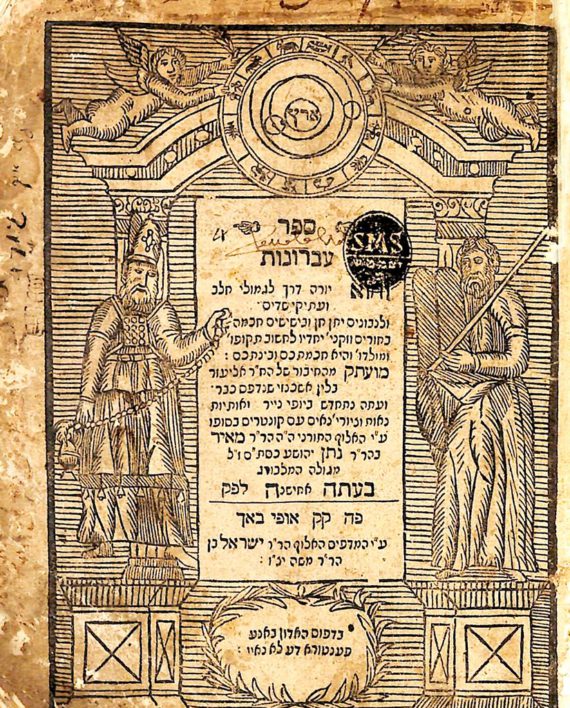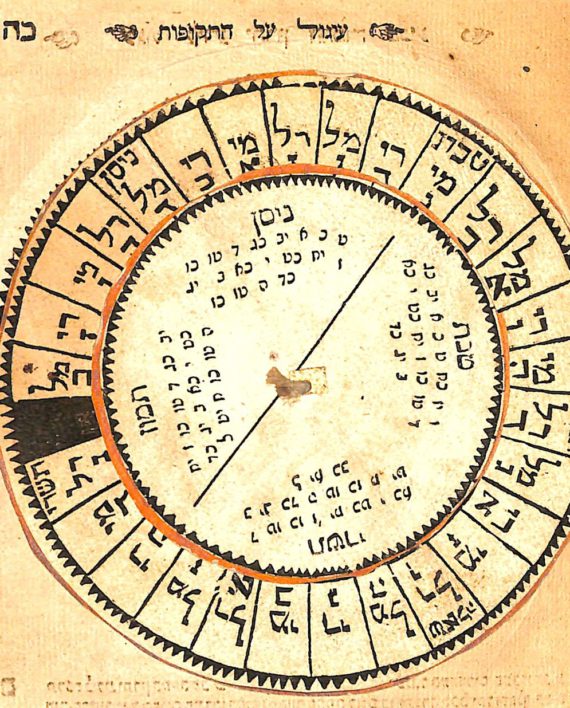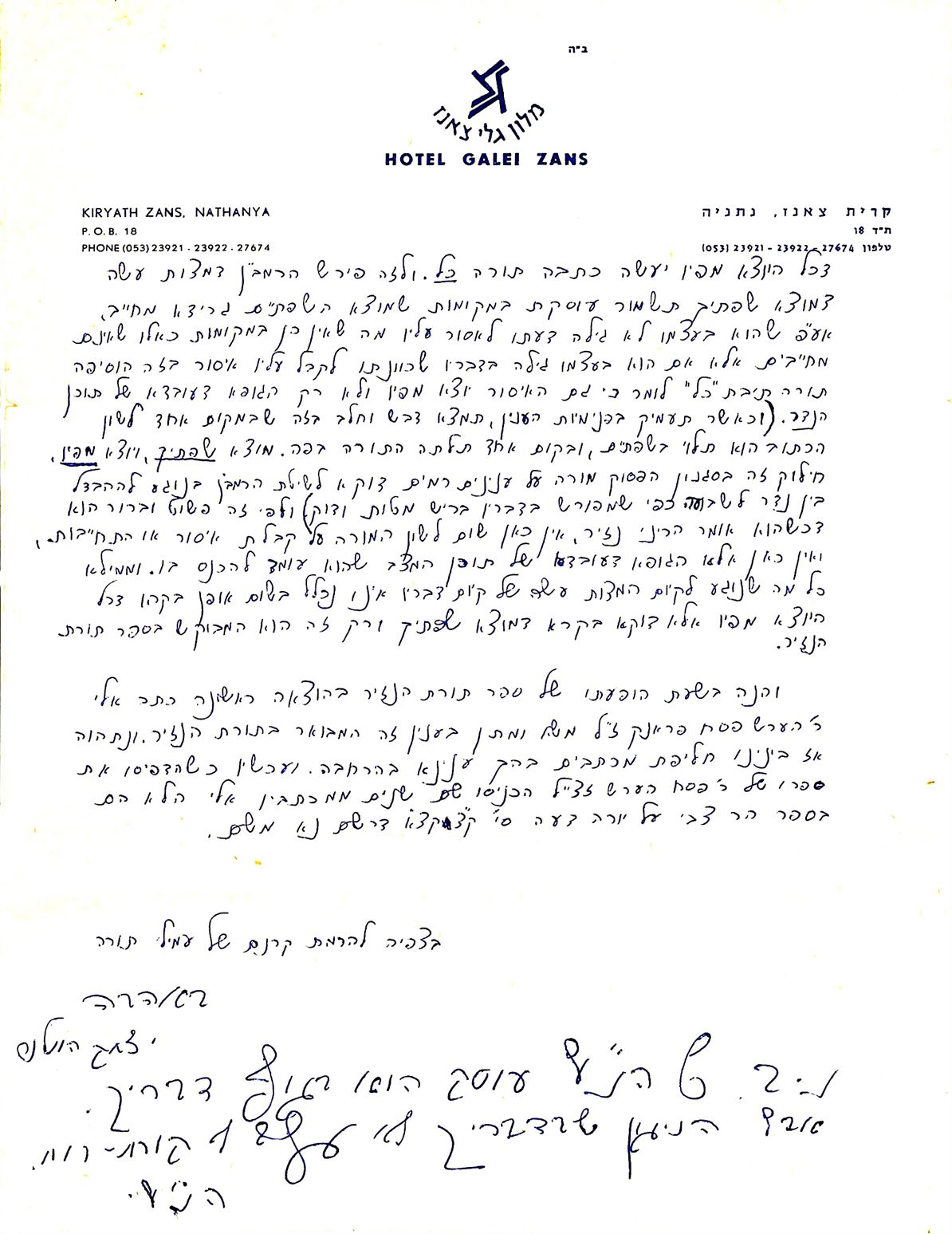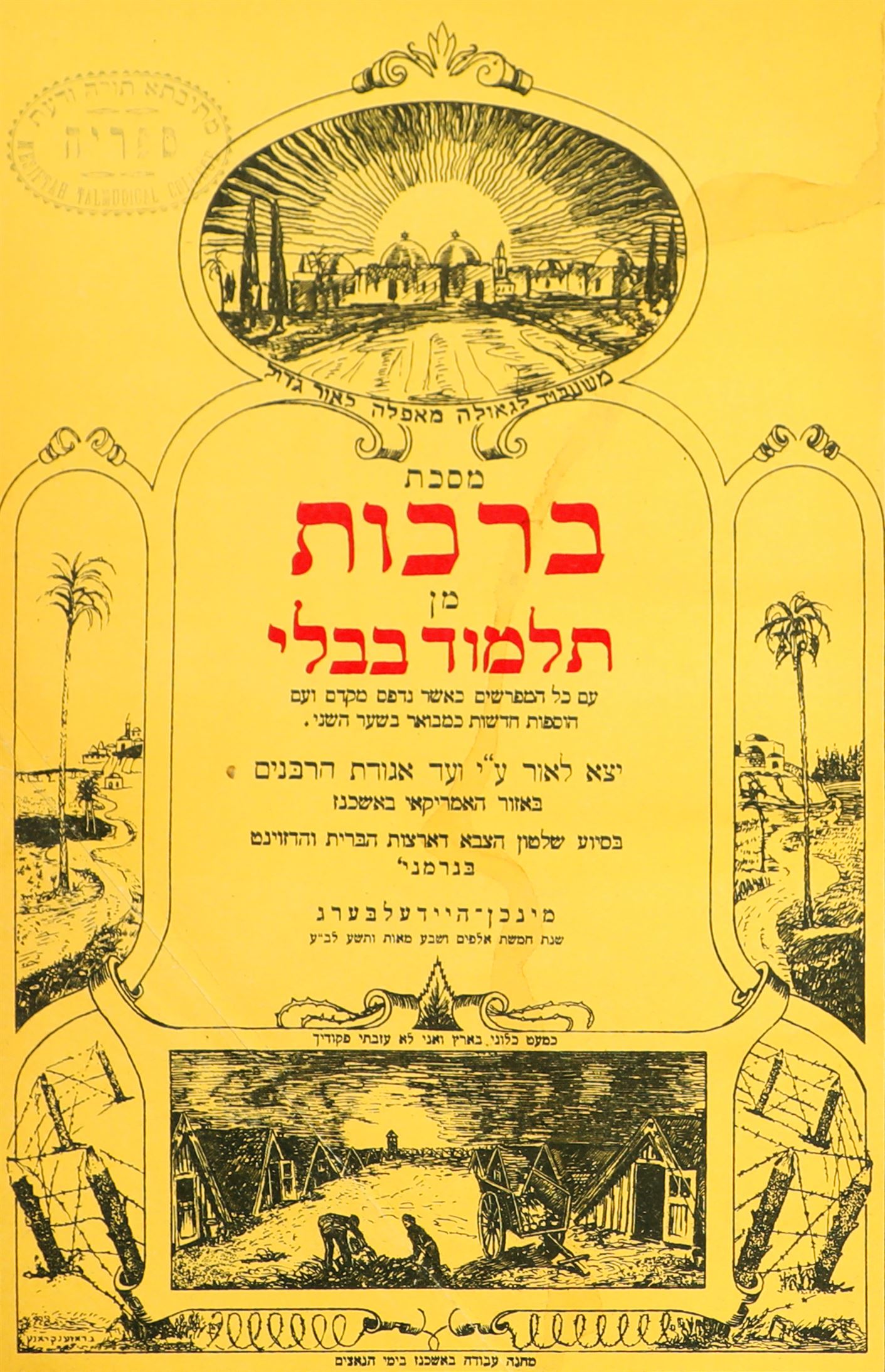Legacy Judaica: Astrological Title Pages, R. Hutner, and Other Items of Note
Legacy Judaica‘s Spring auction is on May 8, 2022. The catalog includes some especially rare first editions, Siddur ha-Shelah, (no. 119), Mesilat Yesharim (no. 45), a volume of the Bomberg edition of the Talmud (lot 10), and some other items of interest.

Sefer Evronot, Offenbach, 1722, (lot no. 63) is an unusual Hebrew book because it includes paper cut-outs that are reattached to the book and form an interstellar calculator allowing precise determination of the calendar. Despite the celestial nature of the work, at the top center of the title page, held aloft by putti, is a depiction of the universe. The earth is in the center, but unlike a geocentric approach with the sun circling the earth, there is no reference to the sun, only the planets. The image depicts the orb system of planets and pre-dates even Copernicus’s theory. (See, Ariel Cohen, “The Celestial Host, the Calendar, and Jewish Art,” in Written in the Stars: Art and Symbolism of the Zodiac, ed. Iris Fishof (Jerusalem: Israel Museum, 2001), 18). Israel ben Meir (his father was a noted publisher) and his non-Jewish partner, Bonaventura de Launoy, published the book. (See Marvin Heller, Essays in the Making of the Hebrew Book (Leiden: Brill, 2021), 273-92).

The Sefer Evronot is not the book for which this title page was designed. Instead, Israel first used the illustration on Abraham ben Hiya’s, Tzurat ha-Arets (Offenbach, 1720). The image is appropriate for the book as it also discusses the solar system’s depiction. This is one of the earliest examples of a title page illustration allusion to the book’s contents and not serving an aesthetic purpose.
A similar illustration to the title page’s celestial illustration appears in the book. 58a. But the one in the book is less sophisticated than the title page; that one contains a very detailed zodiac. Although it was specifically created for a Hebrew book it didn’t stop the ubiquitous error of depicting Aaron with a bishop’s miter, this time with a cross clearly visible. The Moses and Aaron theme title page first appeared in 1610 in Hanua. One year later, it was used in another book, Nishmat Adam, (lot no. 11), although that one does not have a cross.
The zodiac title page illustration appears on at least two other of Israel’s books that have no association with celestial ideas: a commentary on Birkat ha-Mazon and Zemirot, Mateh Yehuda, (Offenbach,1721) and a Haggadah with the commentary Zera Yehuda (Offenbach, 1721). Israel printed over 40 books, and it is unclear why he decided to use it on these two books that seemingly have no relationship to the image.
There are two items related to R. Hutner’s Torat ha-Nazir. Lot 70, is the first edition published in softcover format in Kovno in 1932. This is the only edition that R. Kook’s approbation appears. The later editions of Torat HaNazir remove it. In some editions, all the approbations are removed and in others, R. Chaim Ozer’s was retained. (although the printers did not alter the original heading, “Letters of the Ge’onim.” See Marc Shapiro, Changing the Immutable (Oxford: Littman, 2015), 157-160.
Another item related to the Torat Ha-Nazir is a letter to an unidentified correspondent (lot 236). Apparently, R. Hunter chanced upon that person’s copy of Torat ha-Nazir with their notes. One of which took issue with R. Hutner’s approach, and he defended himself. R. Hutner added a postscript that the tone was inappropriate whatever the objections (in the margins).
 Lot 223 is a letter from R. Chaim Ozer regarding cremation. Although today after the Holocaust it seems difficult to imagine cremation widely accepted by Jews, in the early 20th century, some Orthodox rabbis permitted cremation. R. Ozer’s letter discusses one the main works, Hayyi Olam.
Lot 223 is a letter from R. Chaim Ozer regarding cremation. Although today after the Holocaust it seems difficult to imagine cremation widely accepted by Jews, in the early 20th century, some Orthodox rabbis permitted cremation. R. Ozer’s letter discusses one the main works, Hayyi Olam.
Lot 77 is two broadsides. One is from a list of Rabbis against Heichal Shlomo, against attending a convention. These Rabbis consistently opposed the creation of Heichal Shlomo and the idea of a Central Organization that controlled and spoke for all Orthodox Jews. The Heichal Shlomo board discussed how best to respond to those objections. Ultimately, Zerach Warhftig, argued against responding as they tried to engage and even discuss changing the name but received no response. (See Protocols of the Merkaz HaRuchani HaOlami, January 28, 1958).
The inauguration of Heichal Shlomo occurred on Lag Be’Omer, 1958, to great pomp and circumstance. The mayor held a cocktail party in the garden, and the gentleman was told to wear suits and hats.
There are both editions of the “Survivors Talmud.” (lots 160 & 161).The first edition, published in Munich in1946, only included Nedarim and Kiddushin. In 1948, the American Army published a complete edition of the Talmud. These are the only editions of the Talmud that any government published before the establishment of the State of Israel. There are three introductions, one in English and two in Hebrew. The English one reads in part:
This edition of the Talmud is dedicated to the United States Army. This Army played a major role in the rescue of the Jewish people from total annihilation and after the defeat of Hitler bore the major burden of sustaining the DPs of the Jewish faith. This special edition of the Talmud published in the very land where, but a short time ago, everything Jewish and Jewish inspiration was an anathema, will remain a symbol of the indestructibility of the Torah. […]
Rabbi Samuel A. Snieg, Chief Rabbi of the United States Zone, “Dedication.”
Munich, Germany, 1948 edition of the Talmud printed under the supervision of the Procurement Division, European Quartermaster General Depot, United States Army.

Interesting personal copies one is R. Chaim Ozer’s Achiezer with his inscription (lot 176), R. Chaim Keanievsky’s personal siddur (lot 181), and R. Yaakov Loberbaum’s, the author of the Nesivot ha-Mishpat, copy of Shev Shema’ata (lot 183) and R Chaim Berlin (item 182) a rare volume of Shut Harshaba that R Hirsch got as a gift from his father (item 179) and two items from the Beis Halevi’s Library (items 192 &194) [One with unpublished glosses].



12 thoughts on “Legacy Judaica: Astrological Title Pages, R. Hutner, and Other Items of Note”
The handwriting in the referenced footnote of lot 236 seems strikingly different than the contents of the actual letter. I would bet that someone other than the letter’s author added it later.
According to the entry in the catalog, the letter was drafted by R Hutner’s wife, Bruria David, and the postscript is in R Hutner’s hand.
BruriaDavid is his daughter (not wife)
“The earth is in the center, but unlike a geocentric approach with the sun circling the earth, there is no reference to the sun, only the planets. The image depicts the orb system of planets and pre-dates even Copernicus’s theory.”
Whoever wrote that had no clue what he was writing about. In the image above the earth is indeed in the centre and the sun and moon are depicted orbiting the earth. The extra circles depict the orbs of the sun which come to fill in the empty space due to the sun’s deferent.
Searching for the term ‘orb system of the planets’ in Google, returns no results, and I am not sure what it even means. If it means that the planets are placed with an orb and do not orbit freely, then that is the Greek and Arabic system and obviously predates Copernicus. However, Copernicus retained this part of Greek astronomy and it was rejected only by Brahe.
“These are the only editions of the Talmud that any government published before the establishment of the State of Israel.”
Has the State of Israel ever published an edition of the Talmud? The Academy of the Hebrew Language published a one-volume Yerushalmi based on the Leiden manuscript (the only manuscript of the Yerushalmi), so maybe that counts. The same publishing company that prints local city ordinance books also prints one-volume editions of the Yerushalmi, Bavli, Rambam, and Shulchan Aruch, but that’s a private company. And I imagine R’ Steinsaltz may have gotten some public funding for his Shas.
Is it true that some chasid of R’ Hutner buys up all copies of the first edition so no one can know that R’ Kook gave a haskama?
“The inauguration of Heichal Shlomo occurred on Lag Be’Omer, 1958, to great pomp and circumstance. The mayor held a cocktail party in the garden, and the gentleman was told to wear suits and hats.”
In 2018 the beit knesset within the building- of which I am a gabbai- had a 60th anniversary celebration. Future president Herzog was among those in attendance, for obvious reasons. I wonder where the “garden” was- there’s certainly no garden today, but the Great Synagogue wasn’t built (on Heichal Shlomo land) until much later, so maybe it was there.
I’m close with one of this hasid’s grandsons (through marriage), I asked him to ask his grandfather if it’s true. He asked him and he told him that this rumor is nonsense.
Thanks.
Its a good article, and I enjoy a well-placed Latin phrase as much as the next guy, but in this context (in situ) use of the word “putti” for cherubs was a little pretentious.
Is Rav Kook z’l’s haskamah available to read online?
Here’s R’ Hutner’s request for it:
https://twitter.com/ariwaxman/status/1524407706509099009
in einei yisrael from rav yisrael elya weintraub a talmid muvhak of rav hutner there is corresponbence between the 2 over a point in toras hanazir rav hutner writes tha he chanced upon rav elyas copy of the sefer
check it out